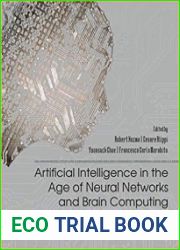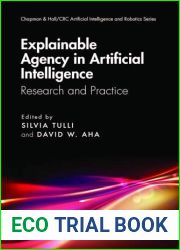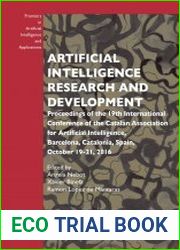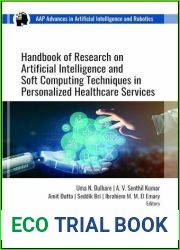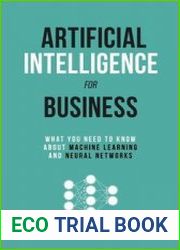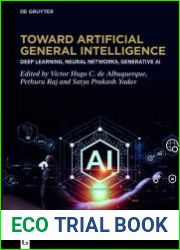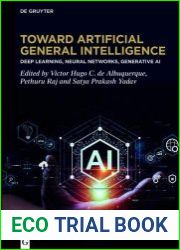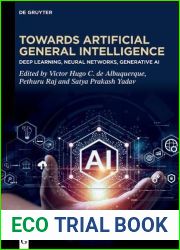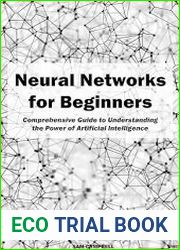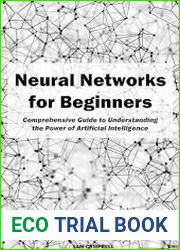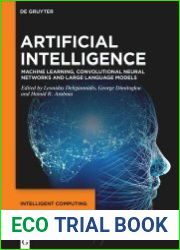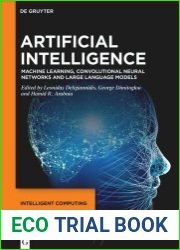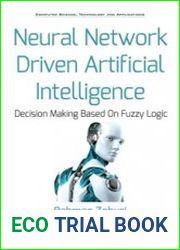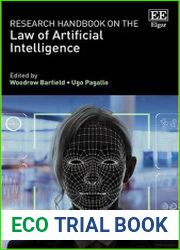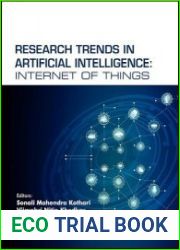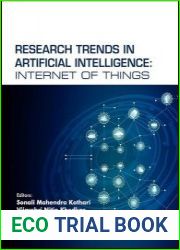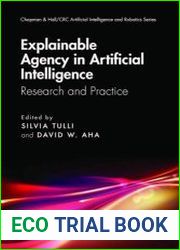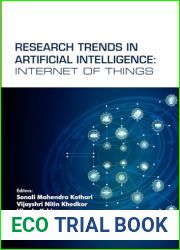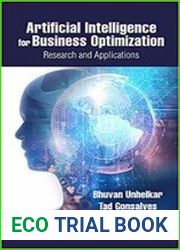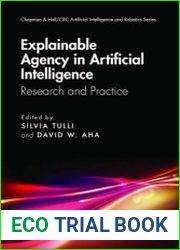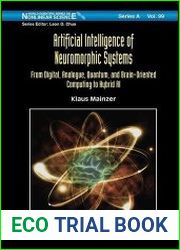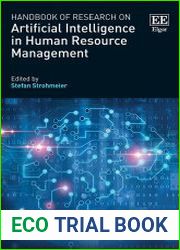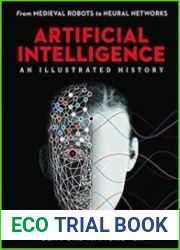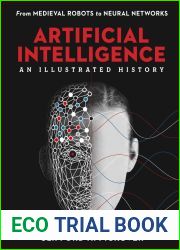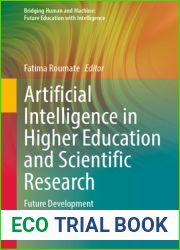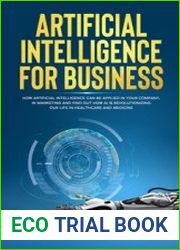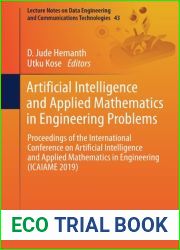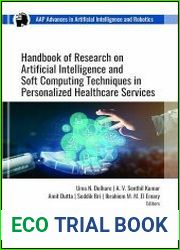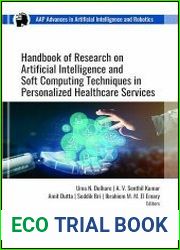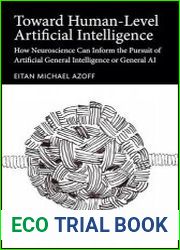
BOOKS - Artificial Intelligence and Brain Research Neural Networks, Deep Learning and...

Artificial Intelligence and Brain Research Neural Networks, Deep Learning and the Future of Cognition
Author: Patrick Krauss
Year: 2024
Pages: 258
Format: PDF | EPUB
File size: 15.3 MB
Language: ENG

Year: 2024
Pages: 258
Format: PDF | EPUB
File size: 15.3 MB
Language: ENG

Artificial Intelligence and Brain Research: Neural Networks, Deep Learning, and the Future of Cognition As technology continues to advance at an unprecedented pace, it is essential to understand the process of its evolution and the impact it has on human cognition. The book "Artificial Intelligence and Brain Research: Neural Networks, Deep Learning, and the Future of Cognition" provides an in-depth exploration of the interconnectedness between artificial intelligence (AI) and brain research, offering insights into the similarities and differences between natural and artificial intelligence, the potential of AI to revolutionize our understanding of the brain, and the challenges and opportunities that come with these advancements. The book begins by delving into the basics of AI, explaining how it works and the parallels it shares with the human brain. It explores the concept of neural networks and the term Deep Learning, making it accessible to readers who may be new to the field. The author highlights the cognitive revolution that took place in the middle of the last century, which brought about a significant shift in the way we understand the brain and its functions. This shift has led to breakthroughs in AI, such as alphaGo, DALLE 2, and ChatGPT, which were previously unthinkable. However, the book does not only focus on past achievements; it also looks at the innovations of tomorrow, such as hybrid machine learning and neurosymbolic AI. These advancements have the potential to further transform our understanding of the brain and AI algorithms. The author explains how findings from brain research are being used in computer science to develop AI algorithms, providing a deeper understanding of the human brain and its functions.
Искусственный интеллект и исследования мозга: нейронные сети, глубокое обучение и будущее познания Поскольку технология продолжает развиваться беспрецедентными темпами, важно понимать процесс ее эволюции и влияние, которое она оказывает на человеческое познание. Книга «Artificial Intelligence and Brain Research: Neural Networks, Deep arning, and the Future of Cognition» дает глубокое исследование взаимосвязанности между искусственным интеллектом (ИИ) и исследования мозга, предлагающие понимание сходств и различий между естественным и искусственным интеллектом, потенциал ИИ для революции в нашем понимании мозга, а также проблемы и возможности, которые возникают в связи с этими достижениями. Книга начинается с того, что углубляется в основы ИИ, объясняет, как он работает, и параллели, которые он разделяет с человеческим мозгом. В нем исследуется концепция нейронных сетей и термин Deep arning, что делает его доступным для читателей, которые могут быть новичками в этой области. Автор выделяет когнитивную революцию, произошедшую в середине прошлого века, которая привела к значительному сдвигу в понимании мозга и его функций. Этот сдвиг привел к прорывам в ИИ, таким как alphaGo, DALLE 2 и ChatGPT, которые ранее были немыслимы. Однако книга посвящена не только прошлым достижениям; он также рассматривает инновации завтрашнего дня, такие как гибридное машинное обучение и нейросимболический ИИ. Эти достижения могут еще больше изменить наше понимание мозга и алгоритмов ИИ. Автор объясняет, как результаты исследований мозга используются в информатике для разработки алгоритмов ИИ, обеспечивающих более глубокое понимание человеческого мозга и его функций.
Intelligence artificielle et recherche sur le cerveau : réseaux neuronaux, apprentissage profond et futur de la connaissance Alors que la technologie continue d'évoluer à un rythme sans précédent, il est important de comprendre son évolution et son impact sur la connaissance humaine. livre « Intelligence artificielle et recherche sur le cerveau : Neural Networks, Deep arning, and the Future of Cognition » fournit une étude approfondie de l'interconnexion entre l'intelligence artificielle (IA) et la recherche sur le cerveau, offrant une compréhension des similitudes et des différences entre l'intelligence naturelle et artificielle, le potentiel de l'IA pour la révolution dans notre compréhension du cerveau, et les défis et les opportunités qui découlent de ces réalisations. livre commence par approfondir les fondements de l'IA, explique comment il fonctionne et les parallèles qu'il partage avec le cerveau humain. Il explore le concept de réseaux neuronaux et le terme Deep arning, ce qui le rend accessible aux lecteurs qui peuvent être nouveaux dans ce domaine. L'auteur met en évidence la révolution cognitive qui a eu lieu au milieu du siècle dernier, qui a conduit à un changement significatif dans la compréhension du cerveau et de ses fonctions. Ce changement a conduit à des percées dans l'IA, comme alphaGo, DALLE 2 et ChatGPT, qui étaient auparavant inconcevables. Cependant, le livre ne traite pas seulement des réalisations passées ; il s'intéresse également aux innovations de demain, comme l'apprentissage machine hybride et l'IA neurosimbolique. Ces avancées peuvent encore changer notre compréhension du cerveau et des algorithmes d'IA. L'auteur explique comment les résultats de la recherche sur le cerveau sont utilisés en informatique pour développer des algorithmes d'IA qui permettent une meilleure compréhension du cerveau humain et de ses fonctions.
Inteligencia artificial e investigación cerebral: redes neuronales, aprendizaje profundo y futuro del conocimiento A medida que la tecnología continúa evolucionando a un ritmo sin precedentes, es importante comprender el proceso de su evolución y el impacto que tiene en la cognición humana. libro «Inteligencia Artificial y Investigación de Brain: Neural Networks, Deep Arning, and the Future of Cognition» ofrece una profunda investigación sobre la interrelación entre inteligencia artificial (IA) y estudios cerebrales que ofrecen una comprensión de las similitudes y diferencias entre lo natural y lo natural la inteligencia artificial, el potencial de la IA para revolucionar nuestra comprensión del cerebro, así como los desafíos y oportunidades que surgen de estos avances. libro comienza profundizando en los fundamentos de la IA, explica cómo funciona y los paralelismos que comparte con el cerebro humano. Explora el concepto de redes neuronales y el término Deep arning, lo que lo pone a disposición de los lectores que puedan ser nuevos en este campo. autor destaca la revolución cognitiva que tuvo lugar a mediados del siglo pasado, que llevó a un cambio significativo en la comprensión del cerebro y sus funciones. Este cambio ha llevado a avances en IA como alphaGo, DALLE 2 y ChatGPT que antes eran impensables. n embargo, el libro no sólo trata de logros pasados; también contempla las innovaciones del mañana, como el aprendizaje automático híbrido y la IA neurosimbólica. Estos avances pueden alterar aún más nuestra comprensión del cerebro y los algoritmos de IA. autor explica cómo los resultados de la investigación cerebral se utilizan en informática para desarrollar algoritmos de IA que proporcionan una comprensión más profunda del cerebro humano y sus funciones.
Intelligenza artificiale e ricerca del cervello: reti neurali, apprendimento profondo e futuro della conoscenza Poiché la tecnologia continua ad evolversi a un ritmo senza precedenti, è importante comprendere l'evoluzione e l'impatto che essa ha sulla conoscenza umana. Il libro «Artigial Intelligence and Brain Research: Neurale Networks, Deep arning, and the Future of Cognition» fornisce una ricerca approfondita sulla interconnessione tra intelligenza artificiale (intelligenza artificiale) e sulla ricerca del cervello, che offre la comprensione delle somiglianze e delle differenze tra intelligenza naturale e intelligenza artificiale, il potenziale dell'IA per rivoluzionare la nostra comprensione del cervello, e i problemi e le opportunità che rappresentano derivano da questi progressi. Il libro inizia approfondendo le basi dell'IA, spiega come funziona e i paralleli che condivide con il cervello umano. Esso esamina il concetto di reti neurali e il termine Deep arning, rendendolo accessibile ai lettori che possono essere principianti in questo campo. L'autore evidenzia la rivoluzione cognitiva avvenuta a metà del secolo scorso, che ha portato a un significativo cambiamento nella comprensione del cervello e delle sue funzioni. Questo cambiamento ha portato a progressi nell'intelligenza artificiale, come ad esempio il alphaGo, il 2 e il ChatGPT, che prima erano impensabili. Tuttavia, il libro non riguarda solo i successi passati; prende in considerazione anche le innovazioni di domani, come l'apprendimento automatico ibrido e l'IA neurosimbolica. Questi progressi possono cambiare ulteriormente la nostra comprensione del cervello e degli algoritmi dell'IA. L'autore spiega come i risultati della ricerca sul cervello siano utilizzati nell'informatica per sviluppare algoritmi di IA che permettano una migliore comprensione del cervello umano e delle sue funzioni.
Künstliche Intelligenz und Hirnforschung: Neuronale Netze, Deep arning und die Zukunft der Kognition Da sich die Technologie in einem beispiellosen Tempo weiterentwickelt, ist es wichtig, den Prozess ihrer Entwicklung und die Auswirkungen auf die menschliche Kognition zu verstehen. Das Buch „Artificial Intelligence and Brain Research: Neural Networks, Deep arning, and the Future of Cognition“ bietet eine eingehende Untersuchung der Interkonnektivität zwischen künstlicher Intelligenz (KI) und Hirnforschung, die Einblicke in die Ähnlichkeiten und Unterschiede zwischen natürlicher und künstlicher Intelligenz bietet das Potenzial von KI, unser Verständnis des Gehirns zu revolutionieren, sowie Herausforderungen und die Chancen, die sich aus diesen Errungenschaften ergeben. Das Buch beginnt mit einem Einblick in die Grundlagen der KI, erklärt, wie sie funktioniert und welche Parallelen sie mit dem menschlichen Gehirn teilt. Es untersucht das Konzept neuronaler Netzwerke und den Begriff Deep arning und macht ihn für ser zugänglich, die möglicherweise neu auf dem Gebiet sind. Der Autor hebt die kognitive Revolution hervor, die Mitte des letzten Jahrhunderts stattfand und zu einer erheblichen Veränderung des Verständnisses des Gehirns und seiner Funktionen führte. Diese Verschiebung hat zu Durchbrüchen in KI wie alphaGo, DALLE 2 und ChatGPT geführt, die zuvor undenkbar waren. Das Buch konzentriert sich jedoch nicht nur auf vergangene Errungenschaften; Es befasst sich auch mit den Innovationen von morgen, wie hybrides maschinelles rnen und neurosymbolische KI. Diese Fortschritte könnten unser Verständnis von Gehirn und KI-Algorithmen weiter verändern. Der Autor erklärt, wie die Ergebnisse der Hirnforschung in der Informatik verwendet werden, um KI-Algorithmen zu entwickeln, die ein tieferes Verständnis des menschlichen Gehirns und seiner Funktionen ermöglichen.
Sztuczna Inteligencja i Badania Mózgu: eci Neuronowe, Głębokie Uczenie się i Przyszłość Poznania Ponieważ technologia nadal ewoluuje w bezprecedensowym tempie, ważne jest, aby zrozumieć proces jej ewolucji i wpływ, jaki wywiera na poznawanie człowieka. Książka „Sztuczna inteligencja i badania mózgu: sieci neuronowe, Deep arning i przyszłość poznania” zapewnia dogłębne zbadanie wzajemnych powiązań między sztuczną inteligencją (AI) oraz badania nad mózgiem dające wgląd w podobieństwa i różnice między naturalną i sztuczną inteligencją, potencjał AI do rewolucjonizacji naszego zrozumienia mózgu, a także wyzwania i możliwości wynikające z tych postępów. Książka rozpoczyna się od zagłębiania się w podstawy sztucznej inteligencji, wyjaśniając, jak ona działa, a równolegle dzieli się z ludzkim mózgiem. Bada koncepcję sieci neuronowych i termin Deep arning, dzięki czemu jest dostępny dla czytelników, którzy mogą być nowi w terenie. Autor podkreśla rewolucję poznawczą, która miała miejsce w połowie ubiegłego wieku, co doprowadziło do znacznej zmiany w zrozumieniu mózgu i jego funkcji. Zmiana ta doprowadziła do przełomów w AI, takich jak alphaGo, DALLE 2 i ChatGPT, które były wcześniej nie do pomyślenia. Książka nie dotyczy jednak tylko dotychczasowych osiągnięć; przygląda się również nowościom jutra, takim jak hybrydowe uczenie maszynowe i neurosymbolic AI. Te postępy mogłyby jeszcze bardziej przekształcić nasze zrozumienie algorytmów mózgu i AI. Autor wyjaśnia, jak wyniki badań mózgu są wykorzystywane w informatyce do rozwoju algorytmów AI, które zapewniają głębsze zrozumienie ludzkiego mózgu i jego funkcji.
''
Yapay Zeka ve Beyin Araştırması: nir Ağları, Derin Öğrenme ve Bilişin Geleceği Teknoloji benzeri görülmemiş bir hızda gelişmeye devam ettikçe, evrim sürecini ve insan bilişi üzerindeki etkisini anlamak önemlidir. "Yapay Zeka ve Beyin Araştırması: nir Ağları, Derin Arklama ve Bilişin Geleceği" kitabı, yapay zeka arasındaki bağlantının derinlemesine araştırılmasını sağlar. (AI) ve beyin araştırması, doğal ve yapay zeka arasındaki benzerlikler ve farklılıklar, AI'nın beyin anlayışımızda devrim yaratma potansiyeli ve bu gelişmelerden kaynaklanan zorluklar ve fırsatlar hakkında fikir veriyor. Kitap, AI'nın temellerini inceleyerek, nasıl çalıştığını ve insan beyniyle paylaştığı paralellikleri açıklayarak başlıyor. nir ağları kavramını ve Derin arklama terimini araştırır ve bu alanda yeni olabilecek okuyucular için erişilebilir olmasını sağlar. Yazar, geçen yüzyılın ortalarında gerçekleşen ve beyni ve işlevlerini anlamada önemli bir değişime yol açan bilişsel devrimi vurgulamaktadır. Bu değişim, AI'da alphaGo, DALLE 2 ve ChatGPT gibi daha önce düşünülemeyen atılımlara yol açtı. Ancak, kitap sadece geçmiş başarılarla ilgili değil; Ayrıca hibrit makine öğrenimi ve nörosimbolik AI gibi yarının yeniliklerine de bakıyor. Bu ilerlemeler, beyin ve AI algoritmaları hakkındaki anlayışımızı daha da değiştirebilir. Yazar, beyin araştırma bulgularının bilgisayar bilimlerinde insan beyninin ve işlevlerinin daha derin bir şekilde anlaşılmasını sağlayan AI algoritmaları geliştirmek için nasıl kullanıldığını açıklıyor.
الذكاء الاصطناعي وأبحاث الدماغ: الشبكات العصبية، والتعلم العميق، ومستقبل الإدراك مع استمرار تطور التكنولوجيا بوتيرة غير مسبوقة، من المهم فهم عملية تطورها وتأثيرها على الإدراك البشري. يقدم كتاب «الذكاء الاصطناعي وأبحاث الدماغ: الشبكات العصبية والتعلم العميق ومستقبل الإدراك» استكشافًا متعمقًا للترابط بين الذكاء الاصطناعي (AI) وأبحاث الدماغ التي تقدم رؤى حول أوجه التشابه والاختلاف بين الذكاء الطبيعي والاصطناعي، وإمكانية الذكاء الاصطناعي لإحداث ثورة في فهمنا للدماغ، والتحديات والفرص التي تنشأ عن هذه التطورات. يبدأ الكتاب بالخوض في أساسيات الذكاء الاصطناعي، وشرح كيفية عمله وأوجه التشابه التي يتشاركها مع الدماغ البشري. يستكشف مفهوم الشبكات العصبية ومصطلح التعلم العميق، مما يجعله في متناول القراء الذين قد يكونون جددًا في هذا المجال. يسلط المؤلف الضوء على الثورة المعرفية التي حدثت في منتصف القرن الماضي، مما أدى إلى تحول كبير في فهم الدماغ ووظائفه. أدى هذا التحول إلى اختراقات في الذكاء الاصطناعي مثل AlphaGo و DALLE 2 و ChatGPT لم يكن من الممكن تصورها في السابق. ومع ذلك، فإن الكتاب لا يتعلق فقط بالإنجازات السابقة ؛ كما أنه ينظر في ابتكارات الغد، مثل التعلم الآلي الهجين والذكاء الاصطناعي العصبي. يمكن لهذه التطورات أن تغير فهمنا لخوارزميات الدماغ والذكاء الاصطناعي. يشرح المؤلف كيف يتم استخدام نتائج أبحاث الدماغ في علوم الكمبيوتر لتطوير خوارزميات الذكاء الاصطناعي التي توفر فهمًا أعمق للدماغ البشري ووظائفه.












